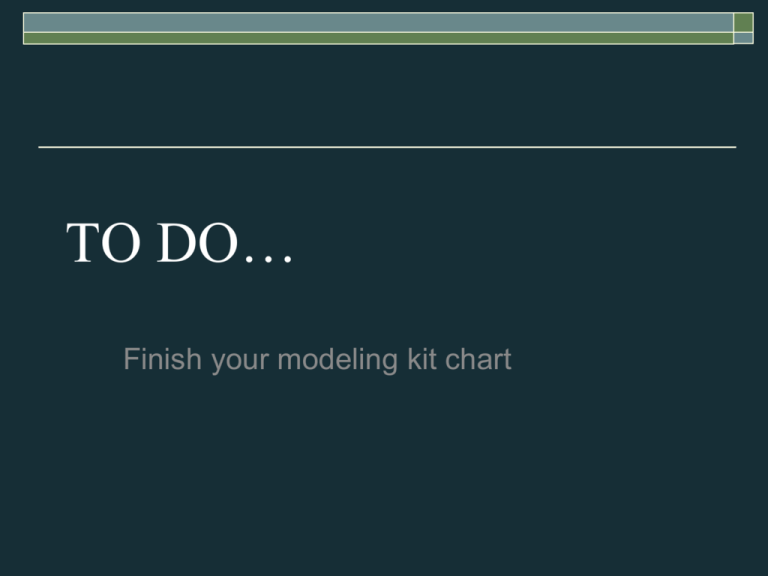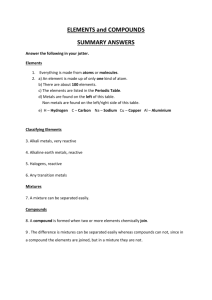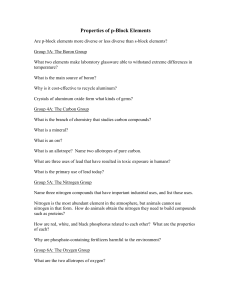12_5_11_pollutants_day1
advertisement

TO DO… Finish your modeling kit chart Building Models – With your table partners: Use the element model kit at your table to build all components that are present in our air. Everyone at your table must contribute at least one compound or molecule to the group. Use the key below as a guide: Blue = Nitrogen Red = Oxygen SIlver = Argon Black = Carbon – Make sure all compounds that your build are stable or “happy” with their desired amount of valence electrons. If they are not stable, fix them! (They should all be stable compounds) Building Compounds • Step 5: Sketch your compounds – In your journal create the following chart for each compound in air – You must have a total of 6 drawings • • • • • • Nitrogen Oxygen Argon Carbon Dioxide Water Vapor Methane Repeat this chart for the other three compounds listed above. Nitrogen Oxygen Argon Sketch Model Sketch Model Sketch Model Lewis Structure Lewis Structure Lewis Structure Compound Formula Compound Formula Compound Formula Answer the following questions in the TO-DO section of your journal….Title it Bonding Review 1. 2. 3. 4. 5. 6. How can you tell if an element or compound is stable? Pollutants are unstable compounds. Are the compounds in our air that you built today pollutants? How do you know? What did the sticks represent in your models? There are three types of bonding (Ionic, Covalent, Metallic). Which type of bonds were created with your model kits today and how do you know? Why didn’t argon have any holes? What does that tell you about an element’s ability to react/bond with another element? Make a prediction as to which element the yellow model would represent and why? Counting Compounds Today’s goal is to learn how to count the number of elements in each compound… Small subscript numbers count for the element symbol BEFORE the subscript EX. H2O (The small 2 means there are two Hydrogens and only one oxygen) A big coefficient BEFORE the element symbol represents multiplication (like in math) EX. 2H2O = 2 sets of two Hydrogen (4 Hydrogens) and only one oxygen Try a harder one… C2H5OH C=? H=? O=? Total = ? 2C2H5OH C=? H=? O=? Total = ? ANSWERS ON NEXT SLIDE… Answers… C2H5OH C=2 H=6 O=1 Total = 9 2C2H5OH C=4 H = 12 O=2 Total = 18 PRACTICE TIME Grab a Counting Atoms Worksheet and complete both sides. You may need to use a computer (Google) to help you identify the compound formulas of problems 9 – 16 Here is a start: http://www.chem4kids.com/files/atom_naming.html Air Quality Demo Color Key Blue—pollutants from consumer products and paints (VOCs) Green—pollutants from lawn, garden, and construction machinery (CO, NO2, PM10, SO2, and VOCs) Red—pollutants from cars and trucks (CO, NO2, PM10, SO2, and VOCs) Yellow—pollutants from power plants and industrial processes (CO, NO2, PM10, SO2, and VOCs) Combustion Reading & Model Kits Grab an Air Quality book from the side counter and read pages 97-100. In your journal (lab tab), create an entry called Combustion and Particulate Matter Define the following words as you read: Combustion Soot Fuel Also: Answer all “Stop & Think” questions in your journal. After reading, complete the model kit activity on page 99-100 and document your structures in your journal Sickening Six Reading Guide… Copy the chart below into your journal and fill it in as you read pages 114-120 in your Air Quality book. After you are done with the chart, answer the questions on page 120 in complete sentences. Pollutant Soot (Particulate Matter) Carbon Monoxide Sulfur Dioxide Nitrogen Monoxide Ozone Mercury Compound Formula Effect on Health To Do… Share your sickening six reading chart with your table group If you have not completed, answer questions on pg. 120 Sickening Six Reading Guide… Copy the chart below into your journal and fill it in as you read pages 114-120 in your Air Quality book. After you are done with the chart, answer the questions on page 120 in complete sentences. Pollutant Soot (Particulate Matter) Carbon Monoxide Sulfur Dioxide Nitrogen Monoxide Ozone Mercury Compound Formula Effect on Health “Rap” it Up… Pick a group of three…you will create a 1-2 minute rap for your air pollutant… We will act it out as a class… 10 minutes to plan it out… Air Quality Activity Each individual at your desk will need: Clear plastic cup filled ¾ with water Box of food dye Journal open to “Daily Activities” to record notes and observations: Title it AIR QUALITY ACTIVITY Copy the notes on the next page and complete the activity as a class… AIR QUALITY: POLLUTION







